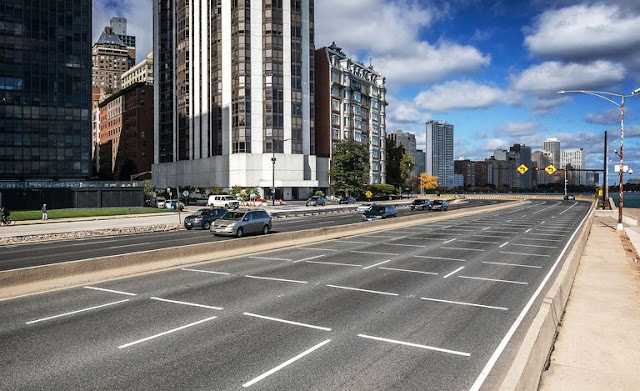How Road Designers Are Manipulating Us into Being More Careful Drivers
Our roads might start to look significantly different in the near future—and finally begin to get safer.
New cars have more safety technology than ever, and
yet accident rates and road fatalities are on the rise. The reasons
behind the trend and the best way to combat it are hotly debated, but
some city planners think they have the key to reversing it. So-called
nudge theory helped economist Richard Thaler win a Nobel Prize in 2017;
it posits that policies and environments should be designed to encourage
people to make choices that will benefit them in the long run.
When
applied to public roadways, the logic goes that when drivers are
comfortable with their surroundings, they're less likely to pay
attention. So traffic engineers design cues into the roadways that spur
people into changing their behavior without realizing it.
Chicago
was one of the first U.S. cities to experiment with this idea. In 2006,
it painted a series of lines across the road ahead of a dangerous curve
on North Lake Shore Drive. As cars approach the curve, the gaps between
the lines shrink and create the illusion that the car is speeding up,
prompting drivers to step on the brakes.
"A lot of nudge theory is not so much about introducing something new,
but rather repackaging information that's already out there and
presenting it in other ways," says Dr. Mikael Ljung Aust, a technical
specialist at the Volvo Cars Safety Centre. Drivers regularly ignore
signs such as "Dangerous Curve Ahead," but visual cues like the lines on
North Lake Shore Drive work on a subconscious level, and drivers react
to them instinctively.
Chicago traffic engineers reported a 36 percent reduction in crashes at
the North Lake Shore Drive curve in the first six months after
installation. Since then, the Chicago Department of Transportation has
painted the gapped lines at a similar curve, and two additional projects
are pending as of October. Other examples of attention-grabbing road
features can be found all over; the Hawaii DOT, for example, uses
zig-zagging lines on roadways ahead of busy intersections and school
zones and shark's-teeth patterns ahead of blind curves.
Cities such as West Palm Beach, Florida, and
Seattle have delved into so-called shared spaces that intermingle
vehicles, cyclists, and pedestrians with few or no demarcating barriers
or signs. Instead of adding cues, road designers take away conventional
guidance (i.e. lane markings, signage, etc.). In theory, drivers show
more cooperation at intersections when there are no traffic signals, and
they exhibit more caution toward cyclists and pedestrians when there
are no bike lanes, curbs, or sidewalks. "It makes for much safer
interactions," Aust says.
"Traffic is slower, but also safer."
Even
though nudge theory's influence is growing, it's still not a leading
ideology for road design, and critics call its approach to policy
paternalistic. But early implementers like Chicago and Seattle have been
happy with the results and are planning to explore the strategy
further. If those new projects bear more evidence that nudging
encourages sustained behavioral changes and fewer accidents, our roads
might start to look significantly different—and finally begin to get
safer.
Do you want to get the more information about sprinter commercial van and refrigerated van for sale near me, then please contact us in the comment section and send your queries regarding this.
Do you want to get the more information about sprinter commercial van and refrigerated van for sale near me, then please contact us in the comment section and send your queries regarding this.





Comments
Post a Comment